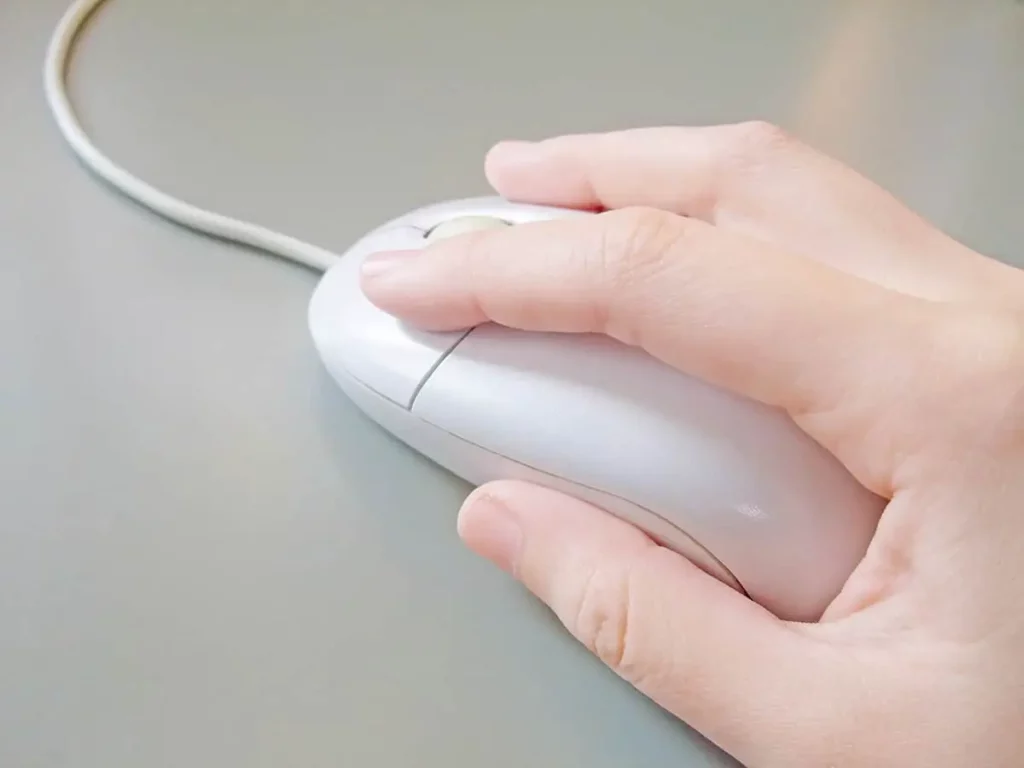How fast and accurate you can aim is crucial when playing games that test your aim, such as first-person shooter (FPS) games. After all, to make progress, you need to eliminate the enemy on time. One key factor to becoming a better gamer is knowing how to hold a mouse for better aim.
Here are 9 tips on how to hold a mouse for better aim:
- Choose a mouse that comfortably fits your hand.
- Find the best mouse grip for you.
- Practice proper mouse posture.
- Position and use your mouse properly.
- Consider using a wrist rest.
- Adjust your mouse controls.
- Load share by alternating between your two hands.
- Clean the mouse.
- Take regular breaks.
Read on to learn, among other things, how to hold your mouse properly and good mouse posture. These tips apply to every PC gamer who wants to improve their aim and boost their performance.
1. Choose a Mouse That Comfortably Fits Your Hand
When it comes to computer mice, there isn’t a one-size-fits-all. So for starters, you want to ensure the size, shape, and type of mouse you purchase perfectly fits the palm of your hand. Consider experimenting with an ergonomic mouse or input device, such as a:
Trackball
With this type of mouse, you use your fingers to move a ball instead of using your arm to move the mouse. Because the mouse remains stationary, a trackball is ideal for use on a desktop with limited space.
And with reduced arm movement comes less risk of repetitive strain injuries (RSIs). The ease of use and increased control of a trackball offers improved tracking accuracy and speed, making a trackball great for intensive mouse use.
I recommend the Logitech MX Ergo (available on Amazon.com) because you can assign preferred functions to the mouse buttons and adjust the angle of the mouse for greater comfort. Plus, you can control up to two computers using the mouse and share files between them by just copying a file on one and pasting it to the other.
Vertical Mouse
A vertical mouse places your wrist and forearm in a handshake position instead of facing down, so you’re less likely to suffer RSIs of the forearm. Vertical mice are also typically available in right-handed and left-handed versions.
The Evoluent VM4R Vertical Mouse (available on Amazon.com) is worth checking out for various reasons. One, it allows you to configure the easy-to-reach buttons to perform nearly any function you like. And two, it has a thumb rest, where your thumb can comfortably sit when using the device.
Just ensure you get the most suitable version for your needs from the wide range of vertical mouse models Evoluent offers. Consider factors such as your dominant hand, hand size, and whether you want a wired or wireless mouse.
Handshoe Mouse
A handshoe mouse fully supports your hand and wrist in a relaxed and more natural position. Its design prevents gripping and pinching, which protects you from carpal tunnel syndrome and other RSIs. And like a vertical mouse also features a thumb rest.
Handshoe mice come in different sizes, are wired or wireless, and are left- or right-sided. To maximize comfort and the advantages of the mouse, ensure the device you purchase is the correct fit for your hand size.
Joystick
The handgrip on a joystick helps maintain a neutral positioning of your hand, wrist, and forearm. It also encourages whole arm movement rather than just wrist movement.
For PC gaming, the Thrustmaster Hotas Warthog Joystick (available on Amazon.com) is one of the best PC joysticks you can buy. It’s very sturdy, features 19 action buttons, and includes HallEffect Accurate Technology for the utmost precision.
RollerMouse
A roller mouse is a pointing device that eliminates gripping. It sits in front of your keyboard, allowing you to control the cursor while your hands remain in a neutral position. It also allows you to alternate between your left and right hand for workload distribution.
Few movements when switching from mousing to typing reduce muscle activity in your hand and fingers. A RollerMouse, therefore, also lessens fatigue and the risk of injury.
So if you experience RSIs, I recommend any one of the various Contour RollerMouse models. All of which provide ergonomic benefits like ambidexterity and reduced reaching. From the RollerMouse Red (available on Amazon.com) to the RollerMouse Pro3, there’s a RollerMouse for every hand size and workstation environment.
2. Find the Best Mouse Grip for You
The best mouse grip is subjective. So, regardless of what pros say is the perfect grip for aiming, if you experience no pain with your current grip and find it comfortable, there’s no need to change. The three most common mouse grips are:
- Palm grip. Many people naturally adopt this grip, making it the most common. Your palm cups the backside of the mouse such that most of your fingers rest somewhat flat on the mouse buttons. The grip feels relaxed and natural hence great for marathon gaming sessions.
- Fingertip grip. With this grip, you move and click the mouse with just your fingers, making it common among gamers with big hands. The fingertip grip allows for faster clicking and better mouse control.
- Claw grip. It’s similar to a palm grip, but you only rest your fingertips on the mouse buttons and elevate your knuckles. As a result, you regain the loss of click accuracy observed with the palm grip.
Like with mouse type, the best grip style comes down to personal preference. So figure out which grip feels comfortable and matches your needs and practice to get used to it.
Whichever one you pick, be sure not to grip the mouse too tightly as it can cause tension, pain, or even injury. Instead, hold the mouse with a relaxed grip.
This video from Dat Good Sir will give you tips on how you can practice your mouse aim:
3. Practice Proper Mouse Posture
Even if you have a premium mouse and have mastered the perfect grip, your aim may continue to be inconsistent if you have poor mouse posture. To use a mouse correctly, consider your workstation ergonomics.
Improper height and angle of your working surface can result in bending your wrists or lifting your arms for extended periods. A comfortable position for mouse use is when your forearm, wrist, and fingers are all in a straight line. That means bending your elbow 90° and having your upper arm hanging comfortably to your side.
So, no angling your wrist up, down, or to either side during mouse use. And no stretching to reach the mouse. If you notice you do this, consider adjusting the height of your working surface or chair.
4. Position and Use Your Mouse Properly
Place your mouse at your side and close to the keyboard to avoid reaching for it. Check that the distance between your hand and forearm is straight and that your elbow is at a 90-degree angle.
Move the mouse from your elbow joint rather than moving your wrist. Don’t elevate or extend your upper arm while using the mouse. Consider using a larger mouse as it encourages arm rather than wrist movements. But ensure it comfortably fits in your hand.
A mouse tray can help keep your mouse in the correct position if you’re often moving it out of place. It ensures you keep your wrist in a neutral position and reduces reach. Lastly, hold your mouse loosely and click the buttons lightly to prevent discomfort, pain, and musculoskeletal injury due to tension.
5. Consider Using a Wrist Rest
Whether or not to use a wrist rest is a matter of debate. Some swear by the devices, saying they help keep wrists straight and relieve tension in the neck and shoulders.
But others condemn their use, citing how they can put increased pressure on the carpal tunnel in the palm side of your wrist, putting users at risk of carpal tunnel syndrome.
When used correctly, however, a wrist rest can be a game-changer literally. It can reduce wrist strain, allow you to maintain a comfortable wrist position, and offer additional support. Consequently, it can help combat RSIs and improve your aim and reflexes.
According to the Occupational Safety and Health Administration (OSHA), suggest that:
- Your heel or palm, not your wrist, should have contact with the wrist rest when resting.
- You adjust other workstation components, including your chair, desk, and keyboard, to help keep your wrist posture straight.
- You use a wrist rest with a reasonably soft surface to minimize pressure on your wrist.
Now, whether or not to use a wrist rest ultimately comes down to your preferences. But if you consistently game for extended periods, you should seriously consider getting one that attaches to your mouse pad.
6. Adjust Your Mouse Controls
Efficient mouse use for better aim goes beyond holding a mouse correctly. For instance, operating a mouse that’s too fast or too slow means you’ll likely end up making unnecessary movements. The frustration can also lead to posture mistakes, including angling your wrist.
So, use the mouse setting on your computer to change pointer/cursor size, adjust cursor and double click speed, and configure the mouse buttons to perform customized functions. Ideally, the buttons on a mouse should respond to light touch but not be so sensitive that you hardly press them to activate them.
Consider using the shortcut and function keys on the keyboard when possible to reduce mouse use.
Load sharing between your two hands gives each hand and wrist ample time to rest and or heal. You’re probably thinking, “But I’m not ambidextrous.” True, but with practice and an ambidextrous mouse, your non-dominant hand can be just as proficient in controlling a mouse as your dominant hand.
I recommend the SteelSeries Sensei Ten Ambidextrous Mouse from Amazon.com, which comes with eight programmable buttons. The device has a sensor optimized for extreme tracking precision (up to 18,000 DPI and 450 IPS). And it has an ergonomic design suitable for claw, fingertip, or palm grip.
8. Clean the Mouse
Excess buildup of dirt and dust can impact your mouse’s performance and, in turn, your aim. You may, for example, notice your mouse becoming less responsive or the cursor moving erratically.
To clean the mouse and boost or restore its performance, you’ll need a cotton cloth and rubbing alcohol. Once you have items in hand, follow these basic instructions:
- Disconnect your mouse from the computer. If plugged in a PS/2 port, remember to turn your PC off first.
- Damp the cotton cloth with the rubbing alcohol and wipe the mouse surface.
- If you have a trackball mouse like the Logitech MX Ergo, which I discussed earlier, you’ll need to remove the trackball. Turn the mouse over and push your finger into the gap between the trackball and casing to pop it out.
- Clean the trackball and its socket as described in step 2.
- Allow the trackball to dry before reinserting it and reconnecting the mouse. If connecting to a PS/2 port, plug it in before turning on the computer.
When pressed for time, you can also try moving your mouse back and forth on a piece of paper. Some of the dust and particles in the mouse should transfer onto it.
9. Take Regular Breaks
Taking frequent breaks at regular intervals can be crucial when using a mouse for long periods. More so if you’re unable to alternate between your left and right hand.
Just walk away from your computer every few minutes to give your hands and wrists time to rest. Doing this can help you avoid a variety of injuries and aches. You can also look into hand exercises for gamers.
Bottom Line
You can hold a mouse in a number of ways, many of which are wrong and result in injury, fatigue, and discomfort. But when you adopt better mouse habits, not only does it reduce your risk for repetitive strain injuries like carpal tunnel syndrome, it also improves your aim and overall performance.
Here are some of the tips discussed in the article for holding and using your mouse correctly:
- Avoid gripping the mouse too tightly.
- Keep your wrists in a straight position.
- Move the mouse using your arm, not your wrist.
- Take frequent breaks!







